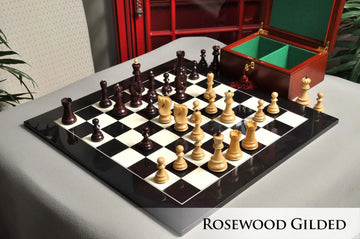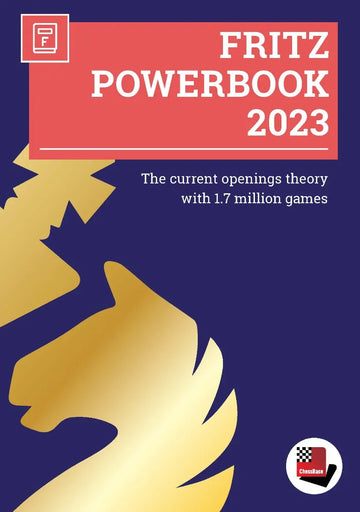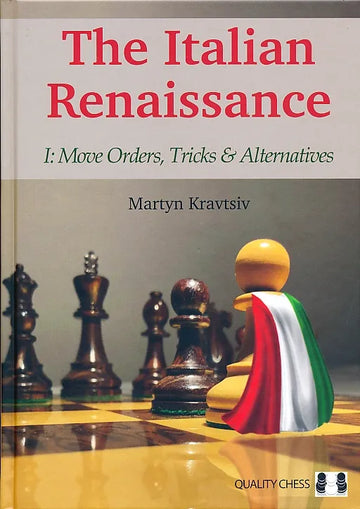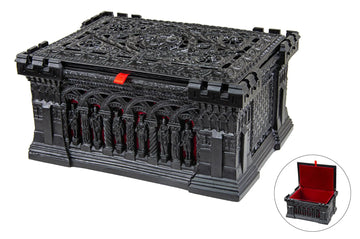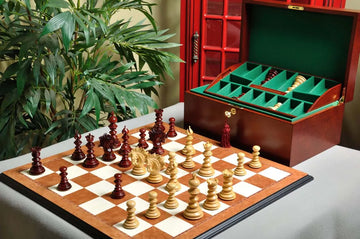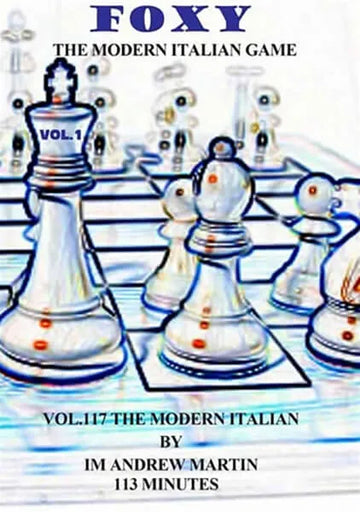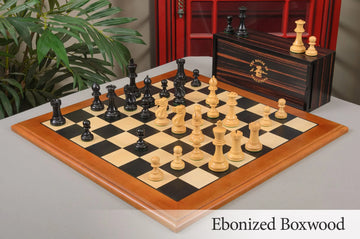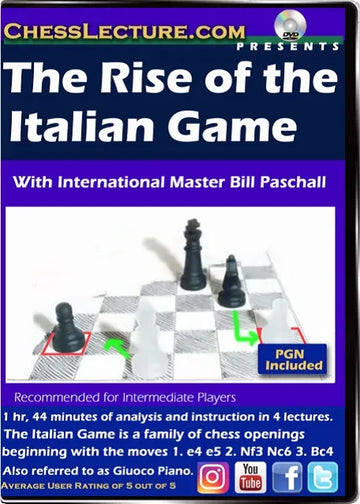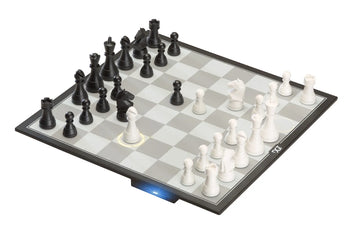The Best Opening vs. Italian Game: The Rousseau Gambit
Grandmaster Igor Smirnov recently described the Rousseau Gambit as ‘The trickiest opening in chess’. Amazingly, this obscure opening that almost nobody knows scores far better than any other answer to the Italian Game at amateur level!
According to Smirnov, the Rousseau Gambit offers Black ‘a trap on every move’. Because intuitive moves fail so badly for White, Black has a great chance to gain a clear advantage early on. It might even win you the game within the first 10 moves!

The Rousseau Gambit – A Cult Hit for the Digital Generation
The Rousseau Gambit was named after French chess master Eugene Rousseau (1805-1870) who spent much of his life in New Orleans. Ignoring conventional opening theory, Black answers the Italian Game with the bizarre-looking 3...f5. Because the opening wasn’t viable at master level, it became banished to obscurity – but that wasn’t the end of the story!
With the advent of online chess databases in the 21st century, off-kilter openings that were virtually unknown began attracting attention for their outstanding win rates. Some prominent chess teachers reasoned that, even if an opening wasn’t strong at master level, it could still be wielded with great success by amateur players.
The Rousseau Gambit is a prime example. Winning far more games for Black against the Italian Game than any other response, Master teachers like Igor Smirnov and Levy Rozman began touting the Rousseau Gambit as a winning formula. The gambit now has an avid cult following, with impressive statistics to back up its popularity!
Chess Database Statistics vs the Italian Game
The Italian Game is one of White's most popular openings at club level. It’s defined by the opening moves 1.e4 e5 2.Nf3 Nc6 3.Bc4 to which Black has myriad replies. While only played by 1% of players, 3...f5, the Rousseau Gambit, stands head and shoulders above the rest!
The following table shows statistics from 64 million games vs. the Italian Game on lichess.org. The stats include all time controls except blitz and bullet, with an average player rating of approximately 1600.
| 3… | Percentage of Games Played | Points Won Per 100 Games |
| Nf6 | 31 | 46 |
| Bc5 | 31 | 48.5 |
| h6 | 17 | 46 |
| d6 | 5 | 45 |
| f5 | 1 | 52.5 |
Notice how the Rousseau Gambit (3...f5) scores at least four points better than any of the most common moves! If White accepts the gambit – and they frequently do – your chances of winning rocket even higher.
If White Accepts the Gambit
By playing 3...f5, your first hope is that White will accept the free pawn. The great news is that this is the most commonly played move at club level! In fact, 4.exf5 is a mistake, and immediately hands Black a whopping 61% upon Black’s next move: 4...e4.

White’s knight is under attack – but look carefully, where will it go? All squares except its starting square (g1) are under attack. In 90% of games, White will now either undevelop the knight back to square one (5.Ng1) or pin your attacking pawn with (5.Qe2) – both of which are losing.
5.Ng1
Undeveloping the knight has effectively cost White two tempos – which is a lot of time within the first five moves! Black can now develop rapidly and go on the attack - but only after doing a little housekeeping! Because your f-file is now open, it’s prudent to play 5...Nf6 to prevent queen attacks on h5 before you continue.
As a bonus, Nf6 also bolsters d5. After this, in most lines you can follow with 6...d5, attacking White’s bishop and winning yet another tempo! Capture White’s hanging f5 pawn, now you’re equal on material and light years ahead on development!

5.Qe2
To avoid undeveloping the knight, White may try to pin your pawn with 5.Qe2 – but this only makes matters worse! Black simply unpins the pawn with 5...Qe7 and Ng1 is still inevitable. Next, protect your king with 6...Nf6. After this, 40% of opponents fall into a terrible trap!
The d3 Trap!
After White’s embarrassing knight retreat, your opponent may well feel resentful of your e4 pawn and try to remove it right away: 7.d3 seems like a natural move to make.
On the face of things 7...Nd4 doesn’t appear such a threatening move, White can simply retreat its queen to d1 or d2 to prevent 8...Nxc2. So, why does Black capture anyway? Look closely at the position below. Do you see White’s dilemma?

Yes! If White captures the knight with its queen, Black follows with ...exd3+, a discovered check that wins the queen! Here's the full line for you to explore: 1. e4 e5 2. Nf3 Nc6 3. Bc4 f5 4. exf5 e4 5. Qe2 Qe7 6. Ng1 Nf6 7. d3 Nd4 8. Qd1 Nxc2+ 9. Qxc2 exd3+
7.Nc3
Better for White is 7.Nc3. From here, stick with 7...Nd4 to challenge White's queen. On the next move, give White another chance to fall into the d3 trap with a preparation move: 7...c6. Even if your opponent plays well, ...d7-d5 dominates the center and wins yet another tempo for Black’s speedy development. Attacks on c2 and discovered checks on the e-file remain a real threat!
5.Nd4!
The Rousseau Gambit may be all about luring White into terrible traps, but Black must be on guard not to fall for any too! By playing 5.Nd4!, White baits Black with a seemingly free knight – so where’s the trap?
If Black captures the knight, White counterstrikes with 6.Qh5+, eventually winning White a rook at the very least. This type of attack should be familiar to any seasoned chess player: If you leave the f-file open before castling, you must always cover your king from flank attacks!
Therefore, if your opponent plays this bold move, be sure to play 5...Nf6 before proceeding. Even though your opponent’s knight has cleverly escaped, you still come off with a favorable position.
If White Declines the Gambit
The strongest way for White to meet the Rousseau Gambit is to decline it – but the danger is not over yet! There still remain many ways for White to slip up on the many banana skins that lie ahead.
4.Nc3?
Playing 4.Nc3 is just as bad for White as accepting the gambit! After 4...fxe4 5.Nxe4 5.d5 forks the knight and bishop, to which White has no good answer!

4.d3
By far the most common way for White to decline the gambit is to defend their king’s pawn with 4.d3. The position now looks similar to the King’s Gambit, but with the colors reversed. Black can play the position in a similar way to that opening by playing 4...Bc5, eyeing an attack on f2 in the near future.
The 5.Ng5 Trap!
The most common way for White to continue is with 5.Ng5, targeting a fork on f7 – but this is inaccurate! Instead of defending f7, Black goes for a symmetrical counterattack, striking at f2 in spectacular style. The following line is so tricky that it only relies on White playing intuitive moves to end up in checkmate!:
1.e4 e5 2.Nf3 Nc6 3.Bc4 f5 4.d3 Bc5 5. Ng5 f4 6. Nf7 Qh4 7. O-O Nf6 8. Nxh8 Ng4 9. h3 Nxf2 10. Rxf2 Qxf2+ 11. Kh1 f3 12. gxf3 d5 13. Bxd5 Bxh3 - now White’s king is cornered with no way to escape checkmate.

Why the Rousseau Gambit Isn’t Played by Grandmasters
As with many obscure openings, there's a good reason why the Rousseau Gambit isn’t played by the masters of the chess world. According to the lichess.org database, out of the nine recorded master games with the Rousseau Gambit, White wins a whopping 73 points from 100 games! This reverses the trend at club level. So where’s the catch?
4.d4
The most successful way for White to refute the Rousseau Gambit is by playing 4.d4. Luckily, only 10% play it at club level, and even then, they’ll often fail to follow with the best moves to win them an advantage.
There are different ways to respond to 4.d4 as Black, but we’ll stick with the safest! Start by capturing on d4 (4...exd4). Now, what will White do?
5.Nxd4
White’s most common response is to recapture with 5.Nxd4 – but it’s not the strongest move. Continue with 5...Nf6 to prevent kingside queen attacks. In most lines, following with d7-d5 opens up a multi-faceted attack that wins a strong position.
5.exf5
If White plays 5.exf5, you can immediately play 5...d5. In the moves that follow, it’s wise to bolster your king with ...Nf6 and also ...Qe7 to take control of the open e-file.
White’s Best Way to Play the Rousseau Gambit: 5.e4
White’s strongest move here is 5.e4. While it does end White with a better position, it’s far from the most intuitive line, meaning you're unlikely to see it too often! In this case, your best line to mitigate the damage is 5...d6 6.exd6 Qxd6. Continue with speedy development and consider castling queenside.

Final Thoughts
The Rousseau Gambit is an aggressive opening that can be dangerous for both sides! If White knows the best moves, it can win a definite advantage. On the other hand, unversed players may struggle to avoid the myriad traps – even at higher levels!
At the end of the day, no other opening comes close to scoring as highly for Black vs. the Italian Game at club level. Try it out for fun in friendly chess matches, or if you’re feeling brave, play it in a tournament for a sure way to unnerve your opponent!

